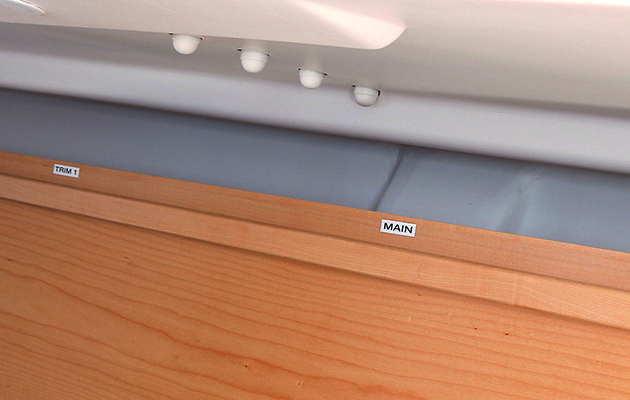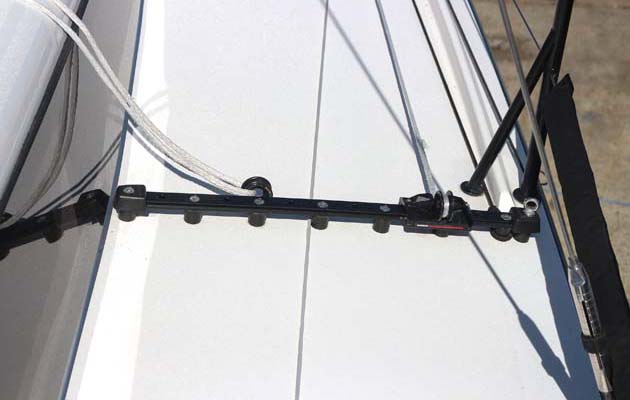The top overall big boat at Cowes Week this year was a production design, Adam Gosling’s new JPK 10.80 Yes! So what makes her special? Rupert Holmes takes a closer look
The JPK 10.80 really caught the attention of the offshore racing fraternity when Géry Trentesaux’s Courrier du Leon won last year’s Rolex Fastnet Race and the entire RORC series overall. Although configured for offshore racing with a small crew, Trentesaux’s boat also turned heads on the inshore scene, particularly in the Royal Yacht Squadron’s Bicentenary Regatta.
“We were competing against Géry in the previous Yes! and were surprised at how well it went, even in light airs,” says Yes! boat captain and crew boss James ‘Heinzy’ Hynes. “But what really turned us on about the boat was a tight reach one day when it sailed through our lee. Their mainsheet trimmer was smoking a pipe, yet they gained half a mile on us, even though their rating was 25 points lower.”
After three years with the previous Yes!, a much updated 1996 Corby 36 which had won Black Group at Cowes Week the previous three years in a row, it was time for a change. “John Corby did incredibly well bringing the boat up to modern standards and we campaigned it very successfully,” says her owner and skipper, Adam Gosling. “But you’ve got to re-challenge yourself.”
Adam Gosling has won his class at Cowes Week for 7 of the past 8 years. The JPK 10.80 is his 13th Yes!
“We wanted to see if the 10.80 could be adapted for inshore racing with a crew of nine,” Hynes continues. “So, four of us, including Sid [David Howlett, Ben Ainslie’s coach in the Finn class, with whom Gosling won the 1996 Etchells worlds] went to the JPK factory in Brittany.”
In particular they wanted to retain the same deck layout as the previous Yes!. That way the team could focus immediately on making the new boat sail fast, rather than relearning manoeuvres.
Yes! is the first JPK 10.80 to be configured solely for inshore racing. No single change is large – all mouldings, the keel and the rudders are identical – but the aggregate gain for Gosling’s team on an inshore course is significant.
“We look for lots of small gains that will add up, not a single big gain that might be a risk,” says Hynes. In addition, he says Gosling maintains an intensity and awareness level that’s well above what an average sailor would consider to be 100 per cent. Jean Pierre Kelbert, founder of JPK Composites, has raced on board and described it as the best sailed boat he has been on.
Main changes
The two biggest changes are winches to control the mainsheet, replicating the system on the previous Yes!, and a keel-stepped mast. This sits on a jack that enables rig tension to be quickly changed simply by placing shims of different thicknesses under the heel of the spar.
With the arguable exception of the mast jack, Yes! is a tweaked production boat, as distinct from a grand prix vessel. However, they also opted for high-end electronics, with a B&G H5000 system fitted by Diverse Yacht Services. This has sensors for heel, fore-and-aft trim and forestay load, with the output logged alongside other performance data. This information has helped identify optimum heel angles across a range of conditions, which has been an important part of getting the new boat up to speed quickly.
Important tweaks
Other changes are predominately tweaks to enable the boat to be sailed more efficiently. For instance, spinnakers are always hatch-hoisted from the forepeak, even on the first downwind leg. A central leecloth in the bunk enables two kites to be stowed there, so both a symmetric and an asymmetric are always ready for action.
The transverse jib sheet track is mounted above the deck, allowing the line that controls the fore-and-aft position of the clew to pass in a straight line underneath it. An extra block doubles the purchase compared to the standard system. There’s no specific line to control the traveller car – releasing the inhauler will allow the car to drop to an outboard sheeting position.
The standard 10.80 deck layout has floating blocks attached to a deck ring, with lines turning through deck organisers as they are led aft. This was changed so that clutches are aligned with their respective lines, rather than the boat’s fore-and-aft line, which obviates the need for the organisers, thus saving weight and reducing friction.
Everything on the boat is calibrated. Every halyard, sheet, tweaker and inhauler is marked with whipping. Even the track for the inboard end of the pole is clearly labelled so it can be raised to exactly the right point in minimal time.
The approach to setting up has clearly paid off. This year – the boat’s first season – Gosling again won Class 5, Black Group overall, and the trophy for the entire regatta at Aberdeen Asset Management Cowes Week. Similarly, he took 1st overall in his class at the IRC Nationals and was 16th monohull to finish the JP Morgan Asset Management Round the Island Race, beating many much higher rated boats and winning Class 1 both on the water and on corrected time by an impressive margin.
“It doesn’t talk to you as much on the helm as a single-rudder boat, but the plus point is that, on a reach, it’s a joy” Adam Gosling
JPK 10.80 Specifications
LOA: 10.80m (35ft 5in)
LWL: 9.40m (30ft 10in)
Beam: 3.65m (12ft 0in)
Draught: 2.20m (7ft 3in)
Displacement: 4,800kg (10,584lb)
Ballast: 1,900kg (4,190lb)

Every crew member has a specific slot in which their kit is stowed and can be found immediately.

The keel-stepped mast has a jack underneath allowing shims to be inserted or removed to change rig tension.

The leecloth in the forepeak allows both a symmetric and an asymmetric spinnaker to be ready for action.

The transverse jib-sheet track enables the clew of the sail to be positioned in three dimensions with ease.

To reduce friction and weight, clutches are aligned with their respective ropes, not the line of the boat.

The revised mainsheet arrangement, with the sheet taken to a winch on each side of the cockpit.

Hynes believes few teams put enough effort into underwater preparation of their hulls. Yes! gleams top and bottom.

Calibration marks on the track for the inboard end of the spinnaker pole.




